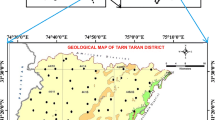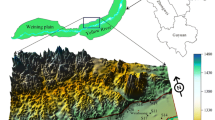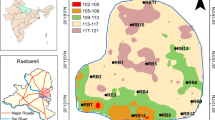Abstract
The current study investigated the hydrogeochemical behavior of groundwater quality attributes including arsenic (As) and their associated health risks in unexplored groundwater aquifers of Bahawalnagar, Punjab, Pakistan. The groundwater samples were collected from 40 colonies of Bahawalnagar city from electric/hand pumps, tube wells and turbines installed at varying depth (20 to > 100 m). The groundwater possessed the highest concentrations of PO4 (0.5 mg/L), HCO3 (425 mg/L), Cl (623 mg/L), NO3 (136.68 mg/L) and SO4 (749.7 mg/L) concentrations. There was no difference in concentration of As in shallow and deep aquifers. Interestingly, none of the water samples showed As concentration higher than the WHO limit of 10 µg/L for drinking water with groundwater As concentration spanning from 2.5 to 7.9 µg/L. The HQ values for As were less than 1 and there was no apparent non-carcinogenic risk from the long-term consumption of As contaminated water. The questionnaire survey indicated that 82% respondents believe that drinking water quality affects human health and 55% of respondents considered that groundwater in the area is not suitable for drinking. Survey results revealed that 29.11, 22.78, 17.08, 15.19, 7.59, 5.06 and 3.16% respondents/family members suffered from hepatitis, skin problems, diabetes, tuberculosis, kidney disorders, muscular weakness and gastro, respectively. However, the data cannot be correlated with As contamination and disease burden in the local community and it can be anticipated that the groundwater may contain other potentially toxic ions that are deteriorating the water quality and compromising human health. The hydrogeochemical analysis revealed Na-Cl/SO4, K-SO4 type of groundwater suggesting the potential role of sulfate containing minerals in releasing As in the groundwater aquifers.





Similar content being viewed by others
Data availability
The data are available upon request from the corresponding author.
References
Abbas, Z., Imran, M., Natasha, Murtaza, B., Amjad, M., Shah, N. S., Khan, Z. U. H., Ahmad, I., & Ahmad, S. (2021). Distribution and health risk assessment of trace elements in ground/surface water of Kot Addu, Punjab, Pakistan: A multivariate analysis. Environmental Monitoring and Assessment, 193, 1–11.
Ahmad, S., Imran, M., Murtaza, B., Natasha, Arshad, M., Nawaz, R., Waheed, A., Hammad, H. M., Naeem, M. A., Shahid, M., & Niazi, N. K. (2021). Hydrogeochemical and health risk investigation of potentially toxic elements in groundwater along River Sutlej floodplain in Punjab, Pakistan. Environmental Geochemistry and Health. https://doi.org/10.1007/s10653-021-00941-y
Aravinthasamy, P., Karunanidhi, D., Subramani, T., Srinivasamoorthy, K., & Anand, B. (2020). Geochemical evaluation of fluoride contamination in groundwater from Shanmuganadhi River basin, South India: Implication on human health. Environmental Geochemistry and Health, 42(7), 1937–1963.
Bozdağ, A. (2016). Assessment of the hydrogeochemical characteristics of groundwater in two aquifer systems in Çumra Plain, Central Anatolia. Environmental Earth Sciences, 75, 674.
Brindha, K., Pavelic, P., Sotoukee, T., Douangsavanh, S., & Elango, L. (2017). Geochemical characteristics and groundwater quality in the Vientiane plain, Laos. Exposure and Health, 9, 89–104.
Chakraborty, B., Roy, S., Bera, A., Adhikary, P. P., Bera, B., Sengupta, D., Bhunia, G. S., Shit, P. K. (2021). Geospatial assessment of groundwater quality for drinking through water quality index and human health risk index in an upland area of Chota Nagpur Plateau of West Bengal, India. Spatial Modeling and Assessment of Environmental Contaminants. Springer, pp. 327–358.
Chatterjee, D., Adak, S., Banerjee, N., Bhattacharjee, P., Bandyopadhyay, A. K., & Giri, A. K. (2018). Evaluatıon of health effects, genetıc damage and telomere length ın children exposed to arsenic in West Bengal, İndia. Mutation Research/genetic Toxicology and Environmental Mutagenesis, 836, 82–88.
Daud, M. K., Nafees, M., Ali, S., Rizwan, M., Bajwa, R. A., Shakoor, M. B., Arshad, M. U., Chatha, S. A. S., Deeba, F., Murad, W., Malook, I., & Zhu, S. J. (2017). Drinking water quality status and contamination in Pakistan. BioMed Research International, 2017, 7908183. https://doi.org/10.1155/2017/7908183
Estefan, G., Sommer, R., Ryan, J. (2013). Methods of soil, plant, and water analysis. A manual for the West AsiaNorth Africa region 3.
Ghosh, S., Basu, M., Banerjee, K., Chaudhury, S. P., Paul, T., Bera, D. K., Pal, D. K., Sk, U. H., Panda, C. K., & Ghosh, A. (2021). Arsenic level in bladder tumor of patients from an exposed population: Association with progression and prognosis. Future Oncology, 17, 1311–1323.
Grönwall, J., & Danert, K. (2020). Regarding groundwater and drinking water access through a human rights lens: Self-supply as a norm. Water, 12, 419.
Hoover, J., Gonzales, M., Shuey, C., Barney, Y., & Lewis, J. (2017). Elevated arsenic and uranium concentrations in unregulated water sources on the Navajo Nation, USA. Exposure and Health, 9, 113–124.
Imran, M., Suddique, M., Shah, G., Ahmad, I., Murtaza, B., Shah, N., Mubeen, M., Ahmad, S., Zakir, A., & Schotting, R. (2019a). Kinetic and equilibrium studies for cadmium biosorption from contaminated water using Cassia fistula biomass. International Journal of Environmental Science and Technology, 16, 3099–3108.
Imran, M., Suddique, M., Shah, G., Ahmad, I., Murtaza, B., Shah, N. S., Mubeen, M., Ahmad, S., Zakir, A., & Schotting, R. J. (2019b). Kinetic and equilibrium studies for cadmium biosorption from contaminated water using Cassia fistula biomass. International Journal of Environmental Science Technology, 16, 3099–3108.
Karavoltsos, S., Sakellari, A., Mihopoulos, N., Dassenakis, M., & Scoullos, M. J. (2008). Evaluation of the quality of drinking water in regions of Greece. Desalination, 224, 317–329.
Kaur, M., Kumar, A., Mehra, R., & Kaur, I. (2020). Quantitative assessment of exposure of heavy metals in groundwater and soil on human health in Reasi district, Jammu and Kashmir. Environmental Geochemistry and Health, 42, 77–94.
Kazi, T. G., Baig, J. A., Shah, A. Q., Arain, M. B., Jamali, M. K., Kandhro, G. A., Afridi, H. I., Kolachi, N. F., Khan, S., & Wadhwa, S. K. (2011). Determination of arsenic in scalp hair of children and its correlation with drinking water in exposed areas of Sindh Pakistan. Biological Trace Element Research, 143, 153–162.
Khalid, S., Murtaza, B., Shaheen, I., Ahmad, I., Ullah, M. I., Abbas, T., Rehman, F., Ashraf, M. R., Khalid, S., Abbas, S. & Imran, M. (2018). Assessment and public perception of drinking water quality and safety in district Vehari, Punjab, Pakistan. Journal of Cleaner Production, 181, 224–234.
Khalid, S., Shahid, M., Natasha, Shah, A. H., Saeed, F., Ali, M., Qaisrani, S. A., & Dumat, C. (2020). Heavy metal contamination and exposure risk assessment via drinking groundwater in Vehari, Pakistan. Environmental Science and Pollution Research, 27, 39852–39864.
Klinkenberg, E., Konradsen, F., Herrel, N., Mukhtar, M., van der Hoek, W., & Amerasinghe, F. P. (2004). Malaria vectors in the changing environment of the southern Punjab, Pakistan. Transactions of the Royal Society of Tropical Medicine and Hygiene, 98(7), 442–449.
Kumar, A., & Singh, C. K. (2020). Arsenic enrichment in groundwater and associated health risk in Bari doab region of Indus basin, Punjab, India. Environmental Pollution, 256, 113324. https://doi.org/10.1016/j.envpol.2019.113324
Kumar, P. S. (2013). Interpretation of groundwater chemistry using piper and Chadha’s diagrams: A comparative study from Perambalur Taluk. Elixir Geosci, 54, 12208–12211.
Kumar, T. P., Mandlimath, T. R., Sangeetha, P., Revathi, S. K., & Kumar, S. A. (2018). Nanoscale materials as sorbents for nitrate and phosphate removal from water. Environmental Chemistry Letters, 16(2), 389–400.
Lanjwani, M. F., Khuhawar, M. Y., Khuhawar, T. M. J., Samtio, M. S., & Memon, S. Q. (2021). Spatial variability and hydrogeochemical characterisation of groundwaters in Larkana of Sindh, Pakistan. Groundwater for Sustainable Development, 14, 100632.
Li, R., Kuo, Y.-M., Liu, W.-W., Jang, C.-S., Zhao, E., & Yao, L. (2018). Potential health risk assessment through ingestion and dermal contact arsenic-contaminated groundwater in Jianghan Plain, China. Environmental Geochemistry and Health, 40, 1585–1599.
Li, Y., Bi, Y., Mi, W., Xie, S., & Ji, L. (2021). Land-use change caused by anthropogenic activities increase fluoride and arsenic pollution in groundwater and human health risk. Journal of Hazardous Materials, 406, 124337.
Marghade, D., Malpe, D. B., Subba Rao, N., & Sunitha, B. (2020). Geochemical assessment of fluoride enriched groundwater and health implications from a part of Yavtmal District, India. Human and Ecological Risk Assessment: An International Journal, 26(3), 673–694.
Mehmood, S., Ahmad, A., Ahmed, A., Khalid, N., & Javed, T. (2013). Drinking water quality in capital city of Pakistan. Science and Reports, 2, 1–6.
Monteiro De Oliveira, E. C., Caixeta, E. S., Santos, V. S. V., & Pereira, B. B. (2021). Arsenic exposure from groundwater: Environmental contamination, human health effects, and sustainable solutions. Journal of Toxicology and Environmental Health, Part B, 24, 119–135.
Murtaza, B., Natasha, Amjad, M., Shahid, M., Imran, M., Shah, N. S., Abbas, G., Naeem, M. A., & Amjad, M. (2020). Compositional and health risk assessment of drinking water from health facilities of District Vehari, Pakistan. Environmental Geochemistry Health, 42, 2425–2437. https://doi.org/10.1007/s10653-019-00465-6
Murtaza, B., Nazeer, H., Natasha, N., Amjad, M., Imran, M., Shahid, M., Shah, N. S., Farooq, A. B. U., Amjad, M., & Murtaza, G. (2020). Hydrogeochemical investigation of arsenic in drinking water of schools and age dependent risk assessment in Vehari District, Punjab Pakistan: A multivariate analysis. Environmental Science and Pollution Research, 27, 30530–30541. https://doi.org/10.1007/s11356-020-09334-7
Mushtaq, N., Masood, N., Khattak, J. A., Hussain, I., Khan, Q., & Farooqi, A. (2020). Health risk assessment and source identification of groundwater arsenic contamination using agglomerative hierarchical cluster analysis in selected sites from upper Eastern parts of Punjab province, Pakistan. Human and Ecological Risk Assessment: An International Journal. https://doi.org/10.1080/10807039.2020.1794787
Natasha, Shahid, M., Imran, M., Khalid, S., Murtaza, B., Niazi, N. K., Zhang, Y., & Hussain, I. (2020). Arsenic environmental contamination status in South Asia. In S. Srivastava (Ed.), Arsenic in drinking water and food (pp. 13–39). Springer.
Natasha, Bibi, I., Shahid, M., Niazi, N. K., Younas, F., Naqvi, S. R., Shaheen, S. M., Imran, M., Wang, H., Hussaini, K. M., Zhang, H., & Rinklebe, J. (2021). Hydrogeochemical and health risk evaluation of arsenic in shallow and deep aquifers along the different floodplains of Punjab, Pakistan. Journal of Hazardous Materials, 402, 124074. https://doi.org/10.1016/j.jhazmat.2020.124074
Phiri, E. (2017). Evaluating opportunities for sustainable rural water provision using solar PV in sub-Saharan Africa: A case study of Malawi. Loughborough University.
Qiao, J., Zhu, Y., Jia, X., Niu, X., & Liu, J. (2020). Distributions of arsenic and other heavy metals, and health risk assessments for groundwater in the Guanzhong Plain region of China. Environmental research, 181, 108957.
Rajesh, R., Brindha, K., Murugan, R., & Elango, L. (2012). Influence of hydrogeochemical processes on temporal changes in groundwater quality in a part of Nalgonda district, Andhra Pradesh, India. Environmental Earth Sciences, 65, 1203–1213.
Rasool, A., Farooqi, A., Masood, S., & Hussain, K. (2016). Arsenic in groundwater and its health risk assessment in drinking water of Mailsi, Punjab, Pakistan. Human and Ecological Risk Assessment: An International Journal, 22, 187–202.
Rehman, F., Cheema, T., Azeem, T., Naseem, A. A., Khan, I., Iqbal, N., Shaheen, A., & ur Rehman, Q. (2020). Groundwater quality and potential health risks caused by arsenic (As) in Bhakkar, Pakistan. Environmental Earth Sciences, 79, 1–13.
Shah, A. H., Shahid, M., Khalid, S., Natahsa, Shabbir, Z., Bakhat, H. F., Murtaza, B., Farooq, A., Akram, M., Shah, G. M., & Nasim, W. (2020). Assessment of arsenic exposure by drinking well water and associated carcinogenic risk in peri-urban areas of Vehari, Pakistan. Environmental geochemistry and health, 42, 121–133.
Shahid, M., Niazi, N. K., Dumat, C., Naidu, R., Khalid, S., Rahman, M. M., & Bibi, I. (2018a). A meta-analysis of the distribution, sources and health risks of arsenic-contaminated groundwater in Pakistan. Environmental Pollution, 242, 307–319.
Shahid, M., Khalid, M., Dumat, C., Khalid, S., Niazi, N. K., Imran, M., Bibi, I., Ahmad, I., Hammad, H. M., & Tabassum, R. A. (2018b). Arsenic level and risk assessment of groundwater in Vehari, Punjab Province, Pakistan. Exposure and Health, 10, 229–239.
Shehzadi, R., Rafique, H., Abbas, I., Sohl, M. A., Ramay, S. M., Mahmood, A., & Sohl, M. N. (2015). Assessment of drinking water quality of Tehsil Alipur, Pakistan. Desalination and Water Treatment, 55, 2253–2264.
Sleet, P. (2019). Water Resources in Pakistan: Scarce, Polluted and Poorly Governed. Independent Strategic Analysis of Australia’s Global Interest. Nedlands, 2.
Tabassum, R. A., Shahid, M., Niazi, N. K., Dumat, C., Zhang, Y., Imran, M., Bakhat, H. F., Hussain, I., & Khalid, S. (2019). Arsenic removal from aqueous solutions and groundwater using agricultural biowastes-derived biosorbents and biochar: A column-scale investigation. International Journal of Phytoremediation, 21, 1–10.
Tariq, M. I., Afzal, S., & Hussain, I. (2004). Pesticides in shallow groundwater of Bahawalnagar, Muzafargarh, D.G. Khan and Rajan Pur districts of Punjab, Pakistan. Environment International, 30, 471–479. https://doi.org/10.1016/j.envint.2003.09.008
USEPA. (2009). United States. Environmental Protection Agency.
USEPA, (2011). Exposure Factors Handbook 2011 Edition (Final). US Environmental Protection Agency, Washington, DC, EPA/600/R09/052F. Retrieved 20 sept 2012 from http://cfpub.epa.gov/ncea/risk/recordisplay.cfm?deid=236252#Download.
Wasserman, G. A., Liu, X., Parvez, F., Chen, Y., Factor-Litvak, P., LoIacono, N. J., Levy, D., Shahriar, H., Uddin, M. N., & Islam, T. (2018). A cross-sectional study of water arsenic exposure and intellectual function in adolescence in Araihazar, Bangladesh. Environment International 118, 304–313.
Acknowledgements
This research was supported by the COMSATS University Islamabad under NRPU/10377.
Author information
Authors and Affiliations
Contributions
ZI, MI, GR Conceived the idea for this article; ZI and Natasha prepared the draft of the paper with BM and MS; MM contributed in preparing some primary parts, and MI and BM, and Natasha reviewed, edited and finalized manuscript; ZI and Natasha read the paper and assisted with the figures and formatting of the paper.
Corresponding author
Ethics declarations
Conflict of interest
The authors declare no conflict of interest.
Additional information
Publisher's Note
Springer Nature remains neutral with regard to jurisdictional claims in published maps and institutional affiliations.
Rights and permissions
About this article
Cite this article
Iqbal, Z., Imran, M., Natasha et al. Spatial distribution, health risk assessment, and public perception of groundwater in Bahawalnagar, Punjab, Pakistan: a multivariate analysis. Environ Geochem Health 45, 381–391 (2023). https://doi.org/10.1007/s10653-021-01182-9
Received:
Accepted:
Published:
Issue Date:
DOI: https://doi.org/10.1007/s10653-021-01182-9




